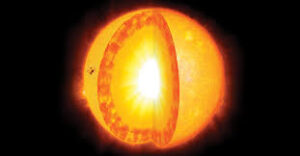A team of Indian researchers from the Indian Institute of Astrophysics (IIA) has introduced a groundbreaking method to precisely estimate the amount of Helium present in the Sun’s photosphere. This approach relies on indirect spectral analysis.

Context
Helium, the Sun’s second most prevalent element, poses challenges for direct detection in the photosphere since its spectral lines are not visible in the optical range.
Historically, scientists have used indirect methods to infer Helium levels, such as:
- Data from the solar wind or corona,
- Observations from hotter stars,
- Helioseismology, which studies the Sun’s internal oscillations.
However, these techniques did not rely on direct observation of the Sun’s photosphere and therefore lacked high accuracy.
Details of the New Approach
The new method involves analyzing spectral lines of neutral Magnesium (Mg I) and Carbon (C I), as well as molecular bands of MgH, CH, and C₂ within the Sun’s photosphere.
The technique is founded on the idea that Helium abundance affects Hydrogen levels, which subsequently alters the formation of molecular lines like CH and MgH.
By comparing the observed atomic and molecular concentrations of Magnesium and Carbon across various Helium-to-Hydrogen (He/H) ratios, the scientists determined that a ratio near 0.1 produces a consistent match, aligning with the known solar Helium value.
About Helium
Helium (He) is a noble gas, notable for its closed-shell electron configuration, which renders it highly stable and non-reactive.
It was first detected in 1868 by Jules Janssen and Norman Lockyer, who observed a distinct yellow spectral line during a solar eclipse.
Its name originates from “Helios,” the Greek word for the Sun.
Major global Helium reserves are found in the U.S., Algeria, and Russia. In India, the Rajmahal volcanic basin in Jharkhand contains ancient, trapped Helium deposits.




